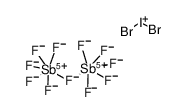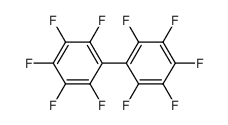| Product name | Antimony pentafluoride |
|---|
| Product number | - |
|---|---|
| Other names | pentafluoro-λ<sup>5</sup>-stibane |
| Identified uses | For industry use only. |
|---|---|
| Uses advised against | no data available |
| Company | MOLBASE (Shanghai) Biotechnology Co., Ltd. |
|---|---|
| Address | Floor 4 & 5, Building 12, No. 1001 North Qinzhou Road, Xuhui District, Shanghai, China |
| Telephone | +86(21)64956998 |
| Fax | +86(21)54365166 |
| Emergency phone number | +86-400-6021-666 |
|---|---|
| Service hours | Monday to Friday, 9am-5pm (Standard time zone: UTC/GMT +8 hours). |
Hazardous to the aquatic environment, long-term (Chronic) - Category Chronic 3
2.2 GHS label elements, including precautionary statements| Pictogram(s) | No symbol. |
|---|---|
| Signal word | No signal word. |
| Hazard statement(s) | H412 Harmful to aquatic life with long lasting effects |
| Precautionary statement(s) | |
| Prevention | P273 Avoid release to the environment. |
| Response | none |
| Storage | none |
| Disposal | P501 Dispose of contents/container to ... |
none
3.Composition/information on ingredients 3.1 Substances| Chemical name | Common names and synonyms | CAS number | EC number | Concentration |
|---|---|---|---|---|
| Antimony pentafluoride | Antimony pentafluoride | 7783-70-2 | none | 100% |
Consult a physician. Show this safety data sheet to the doctor in attendance.
If inhaledFresh air, rest. Half-upright position. Refer immediately for medical attention. See Notes.
In case of skin contactRemove contaminated clothes. Rinse skin with plenty of water or shower. Refer immediately for medical attention. Apply calcium gluconate to the burn areas.
In case of eye contactRinse with plenty of water for several minutes (remove contact lenses if easily possible). Refer immediately for medical attention.
If swallowedRinse mouth. Do NOT induce vomiting. Refer immediately for medical attention.
4.2 Most important symptoms/effects, acute and delayedThe compound is irritating to eyes, skin, and lungs. Contact with eyes or skin causes severe burns. The compound is extremely toxic with a probable oral lethal dose of 5-50 mg/kg or between 7 drops and one teaspoonful for a 150 pound person (antimony salts). (EPA, 1998)
4.3 Indication of immediate medical attention and special treatment needed, if necessary Absorption, Distribution and ExcretionDISTRIBUTION IN RATS AFTER CHRONIC POISONING BY INHALATION OF ANTIMONY PENTAFLUORIDE SHOWED HIGH ANTIMONY CONCN IN BLOOD. LEVELS IN LIVER, KIDNEYS, SPLEEN AND PANCREAS WERE SIMILAR. THE ANTIMONY WAS RETAINED FOR A LONG TIME AND COULD BE DETECTED IN ORGANS UNDER EXAMINATION ONE MONTH AFTER EXPERIMENT DISCONTINUED.
5.Fire-fighting measures 5.1 Extinguishing media Suitable extinguishing mediaApproach fire from upwind to avoid hazardous vapors & toxic decomposition products. Use dry chemical, carbon dioxide or flooding quantities of water as spray on fire involved material.
5.2 Specific hazards arising from the chemicalReacts violently with water, to form poisonous hydrogen fluoride fumes. If confined and wet can cause explosion. May cause fire in contact with combustible material. Hazardous polymerization may not occur. (EPA, 1998)
5.3 Special protective actions for fire-fightersWear self-contained breathing apparatus for firefighting if necessary.
6.Accidental release measures 6.1 Personal precautions, protective equipment and emergency proceduresUse personal protective equipment. Avoid dust formation. Avoid breathing vapours, mist or gas. Ensure adequate ventilation. Evacuate personnel to safe areas. Avoid breathing dust. For personal protection see section 8.
6.2 Environmental precautionsEvacuate danger area! Consult an expert! Personal protection: complete protective clothing including self-contained breathing apparatus. Collect leaking and spilled liquid in sealable containers as far as possible. Do NOT wash away into sewer. Do NOT absorb in saw-dust or other combustible absorbents. Do NOT let this chemical enter the environment. Then store and dispose of according to local regulations.
6.3 Methods and materials for containment and cleaning upPick up and arrange disposal. Sweep up and shovel. Keep in suitable, closed containers for disposal.
7.Handling and storage 7.1 Precautions for safe handlingAvoid contact with skin and eyes. Avoid formation of dust and aerosols. Avoid exposure - obtain special instructions before use.Provide appropriate exhaust ventilation at places where dust is formed. For precautions see section 2.2.
7.2 Conditions for safe storage, including any incompatibilitiesSeparated from combustible substances, reducing agents and food and feedstuffs. Dry. Well closed. Keep in a well-ventilated room. Do NOT store or transport in containers made from metal or glass. Provision to contain effluent from fire extinguishing. Store in an area without drain or sewer access.Store in a cool, dry, well-ventilated location. Outside or detached storage is preferred. Separate from organic or siliceous materials.
8.Exposure controls/personal protection 8.1 Control parameters Occupational Exposure limit valuesRecommended Exposure Limit: 10 Hr Time-Weighted Avg 0.5 mg/cu m. /Antimony/
Biological limit valuesno data available
8.2 Appropriate engineering controlsHandle in accordance with good industrial hygiene and safety practice. Wash hands before breaks and at the end of workday.
8.3 Individual protection measures, such as personal protective equipment (PPE) Eye/face protectionSafety glasses with side-shields conforming to EN166. Use equipment for eye protection tested and approved under appropriate government standards such as NIOSH (US) or EN 166(EU).
Skin protectionWear impervious clothing. The type of protective equipment must be selected according to the concentration and amount of the dangerous substance at the specific workplace. Handle with gloves. Gloves must be inspected prior to use. Use proper glove removal technique(without touching glove's outer surface) to avoid skin contact with this product. Dispose of contaminated gloves after use in accordance with applicable laws and good laboratory practices. Wash and dry hands. The selected protective gloves have to satisfy the specifications of EU Directive 89/686/EEC and the standard EN 374 derived from it.
Respiratory protectionWear dust mask when handling large quantities.
Thermal hazardsno data available
9.Physical and chemical properties| Physical state | clear, colorless liquid. |
|---|---|
| Colour | MODERATELY VISCOUS LIQUID |
| Odour | SHARP ODOR |
| Melting point/ freezing point | 7ºC(lit.) |
| Boiling point or initial boiling point and boiling range | 148-150°C(lit.) |
| Flammability | Not combustible but enhances combustion of other substances. Gives off irritating or toxic fumes (or gases) in a fire. |
| Lower and upper explosion limit / flammability limit | no data available |
| Flash point | 149.5ºC |
| Auto-ignition temperature | no data available |
| Decomposition temperature | no data available |
| pH | no data available |
| Kinematic viscosity | 0.768 cp @ 24.4°C (est) |
| Solubility | Sol in potassium fluoride (KF), liquid sulfur dioxide |
| Partition coefficient n-octanol/water (log value) | no data available |
| Vapour pressure | 10 mm Hg ( 25 °C) |
| Density and/or relative density | 2.993g/mLat 25°C(lit.) |
| Relative vapour density | 2.2 (vs air) |
| Particle characteristics | no data available |
no data available
10.2 Chemical stabilityStable under recommended storage conditions.
10.3 Possibility of hazardous reactionsANTIMONY PENTAFLUORIDE is strongly acidic. Reacts vigorously with bases. When heated to decomposition, it emits highly toxic fumes of fluorides and metallic antimony. Reacts with ammonia to form a diammoniate.
10.4 Conditions to avoidno data available
10.5 Incompatible materialsREACTS VIOLENTLY WITH WATER. ALSO FORMS A SOLID DIHYDRATE, WHICH REACTS VIOLENTLY WITH MORE WATER TO FORM A CLEAR SOLN.
10.6 Hazardous decomposition productsWhen heated to decomp it emits very toxic fumes of /hydrogen fluoride/ and antimony.
11.Toxicological information Acute toxicity- Oral: no data available
- Inhalation: no data available
- Dermal: no data available
no data available
Serious eye damage/irritationno data available
Respiratory or skin sensitizationno data available
Germ cell mutagenicityno data available
CarcinogenicityA4; Not classifiable as a human carcinogen. /Fluorides, as F/
Reproductive toxicityno data available
STOT-single exposureno data available
STOT-repeated exposureno data available
Aspiration hazardno data available
12.Ecological information 12.1 Toxicity- Toxicity to fish: no data available
- Toxicity to daphnia and other aquatic invertebrates: no data available
- Toxicity to algae: no data available
- Toxicity to microorganisms: no data available
no data available
12.3 Bioaccumulative potentialno data available
12.4 Mobility in soilno data available
12.5 Other adverse effectsno data available
13.Disposal considerations 13.1 Disposal methods ProductThe material can be disposed of by removal to a licensed chemical destruction plant or by controlled incineration with flue gas scrubbing. Do not contaminate water, foodstuffs, feed or seed by storage or disposal. Do not discharge to sewer systems.
Contaminated packagingContainers can be triply rinsed (or equivalent) and offered for recycling or reconditioning. Alternatively, the packaging can be punctured to make it unusable for other purposes and then be disposed of in a sanitary landfill. Controlled incineration with flue gas scrubbing is possible for combustible packaging materials.
14.Transport information 14.1 UN Number| ADR/RID: UN1732 | IMDG: UN1732 | IATA: UN1732 |
| ADR/RID: ANTIMONY PENTAFLUORIDE |
| IMDG: ANTIMONY PENTAFLUORIDE |
| IATA: ANTIMONY PENTAFLUORIDE |
| ADR/RID: 6.1 | IMDG: 6.1 | IATA: 6.1 |
| ADR/RID: II | IMDG: II | IATA: II |
| ADR/RID: no | IMDG: no | IATA: no |
no data available
14.7 Transport in bulk according to Annex II of MARPOL 73/78 and the IBC Codeno data available
15.Regulatory information 15.1 Safety, health and environmental regulations specific for the product in question| Chemical name | Common names and synonyms | CAS number | EC number |
|---|---|---|---|
| Antimony pentafluoride | Antimony pentafluoride | 7783-70-2 | none |
| European Inventory of Existing Commercial Chemical Substances (EINECS) | Listed. | ||
| EC Inventory | Listed. | ||
| United States Toxic Substances Control Act (TSCA) Inventory | Listed. | ||
| China Catalog of Hazardous chemicals 2015 | Listed. | ||
| New Zealand Inventory of Chemicals (NZIoC) | Listed. | ||
| Philippines Inventory of Chemicals and Chemical Substances (PICCS) | Listed. | ||
| Vietnam National Chemical Inventory | Not Listed. | ||
| Chinese Chemical Inventory of Existing Chemical Substances (China IECSC) | Listed. | ||
| Creation Date | Aug 16, 2017 |
|---|---|
| Revision Date | Aug 16, 2017 |
- CAS: Chemical Abstracts Service
- ADR: European Agreement concerning the International Carriage of Dangerous Goods by Road
- RID: Regulation concerning the International Carriage of Dangerous Goods by Rail
- IMDG: International Maritime Dangerous Goods
- IATA: International Air Transportation Association
- TWA: Time Weighted Average
- STEL: Short term exposure limit
- LC50: Lethal Concentration 50%
- LD50: Lethal Dose 50%
- EC50: Effective Concentration 50%
- IPCS - The International Chemical Safety Cards (ICSC), website: http://www.ilo.org/dyn/icsc/showcard.home
- HSDB - Hazardous Substances Data Bank, website: https://toxnet.nlm.nih.gov/newtoxnet/hsdb.htm
- IARC - International Agency for Research on Cancer, website: http://www.iarc.fr/
- eChemPortal - The Global Portal to Information on Chemical Substances by OECD, website: http://www.echemportal.org/echemportal/index?pageID=0&request_locale=en
- CAMEO Chemicals, website: http://cameochemicals.noaa.gov/search/simple
- ChemIDplus, website: http://chem.sis.nlm.nih.gov/chemidplus/chemidlite.jsp
- ERG - Emergency Response Guidebook by U.S. Department of Transportation, website: http://www.phmsa.dot.gov/hazmat/library/erg
- Germany GESTIS-database on hazard substance, website: http://www.dguv.de/ifa/gestis/gestis-stoffdatenbank/index-2.jsp
- ECHA - European Chemicals Agency, website: https://echa.europa.eu/




























